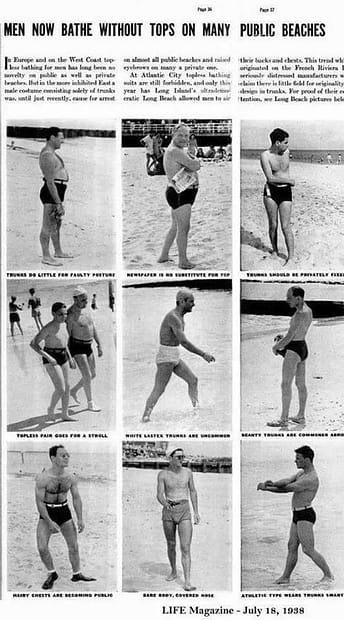It seems that Cape May’s Speedo ban was relatively liberal compared to the beach blanket American Puritanism that preceded it. Until the 1930s you could get arrested on East Coast beaches just for showing your (male) nipples, no matter how baggy and unappetising your swimming trunks were.
In Europe and on the West Coast topless bathing for men has long been no novelty on public as well as private beaches. But in the more inhibited East a male costume consisting solely of trunks was, until just recently, cause for arrest on almost all public beaches and raised eyebrows on many a private one.
At Atlantic City topless bathing suits are still forbidden, and only this year has Long Island’s ultrademocratic Long Beach allowed men to air their backs and chests. This trend which originated on the French Riviera has seriously distressed manufacturers who claim there is little field for originality of design in trunks. For proof of their contention, see Long Beach pictures below.

Male toplessness was banned in most US states until the late 1930s, even at swimming pools and on the beach. To prevent the provocative sight of male nippleage inflaming the lusts of Christian America, they were required to wear soggy woollen tank tops.
But the horror didn’t end there. ‘Swim skirts’ were often attached to them to make sure the eye was not drawn to any Satanic lumps or bumps – and were compulsory in many swimming pools.
New York was one of the last places overturn the ban, in 1937. But most of the trunks on display here after men’s nipple’s were liberated seem to still hanker after the tank-tops, given how high the waists are.
On the one hand it seems laughable that the male breast should have been regarded as so inflammatory of lust to the good burghers of East Coast America. But then again, given the flagrant rise of provocative, pec-tastic spornosexuality on our 21st Century beaches, maybe those clenched American WASPS were right.
At any rate, those trunks certainly aren’t being worn ‘high’ any more. That would be a terrible waste of obliques.
Tip: David Somerlinck
UPDATE 03/12/2020
The Washington Post last year ran a feature about the US ban on male toplessness with some interesting detail and background (some of which I’ve added to the above 2014 post), including a mention of ex-Olympic swimmer Johnny Weissmuller’s seminal toplessness in the hit 1932 Tarzan the Ape movie. Apparently it encouraged American men to rebel against the puritanical restrictions and go ‘bareback’.

The feature then goes on to add:
The problem, of course, was that not all men looked like dreamboat Johnny Weissmuller.
The piece is written by someone with a woman’s name, and I think this was intended as a joke. And I of course don’t have a problem with ‘objectification’ – or bad jokes. But I can only imagine how completely cancelled a male journalist at WaPo would be if he made the same joke about female toplessness.
On the subject though of Weissmuller’s ‘dreamboat’ torso, which was of great inspirational interest to me growing up in the 1970s watching daytime kids TV, it now looks very average indeed. In fact, he looks like a ‘before’ pic in those ‘body transformation’ features in Men’s Health.
As his film career progressed, and his Olympic swimming past receded further and further into the past, Weissmuller began to look more and more like an ad for liposuction. There was a great deal of tummy-sucking going on. (A NYT review of his 1948 film Jungle Jim described him, bluntly, as ‘fat’.)
When he was breaking records and winning gongs for his swimming, Weissmuller was wearing a tank-top for decency’s sake – but a rather skimpier one than most ‘civilians’ had to wear.
And look at how the, er, points of interest, catch the light.


I wonder if it wasn’t good old (West Coast) Hollywood that helped make male nipples – sorry, sun-tans – fashionable?
Here’s a Pre-Code gem called ‘Search For Beauty’, made in 1934 – just before the topless revolution on E Coast beaches:
http://www.youtube.com/watch?v=HSCYKET7K-k
Liberalisation in both men’s and women’s bathing attire in the 20s & 30s US (and UK I imagine, too) was more likely a public health measure: sun was considered protective against TB. This was the era when suntans became fashionable (before that they implied one was a common labourer). While the increased vitamin D might be slightly protective, the real benefit was probably just the fresh air.
Thank God they didn’t know about melanoma!
Comments are closed.